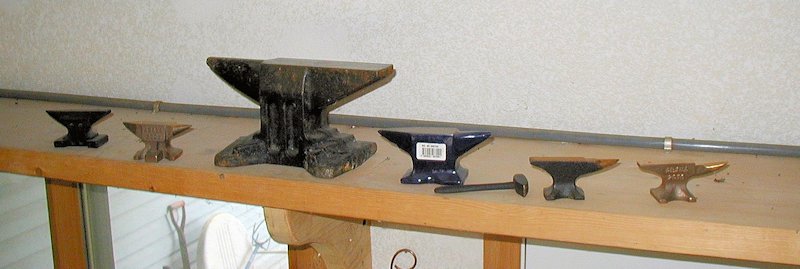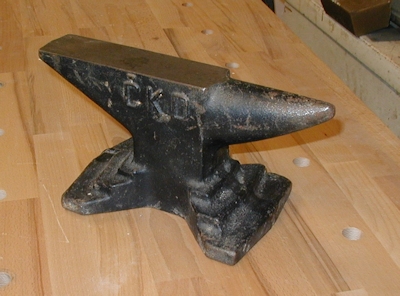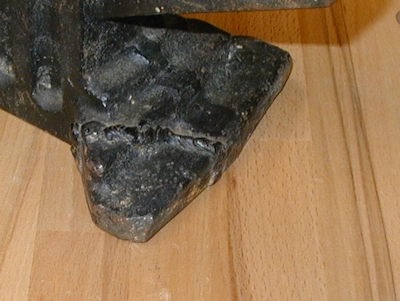
During one of the ABANA Tours, the 1999 trip to Germany, Austria and the Czech Republic, Leonard Masters, our tour
guide par excelance, took delivery of a small anvil that he had ordered previously.
This was early in the trip, maybe we were in Germany.
Here is a picture of some of the smaller anvils that I have collected. The largest one, the third from the left, is the kind
were are talking about:

It was a ten kilogram anvil, of European design, having the "Cathedral" look on one broad side with a slightly
sloped edge. Raised and in large type on the other side are the initials "CKD". The anvil was painted black, horn
included, except for the ground face.
Well, Leonard didn't have room to carry it all across Europe so, at one point, he announced to the bus full of
ABANA travelers that:
"whoever is the first to offer to carry this anvil around for the rest of the trip and to take it back to the States,
can keep it for a year." He went on to say: "And, when I travel across country from the east to the southwest for the
next (year 2000) ABANA conference, I will stop by and pick it up on my way."
Immediately, Guild of Metalsmiths member Bob Fredell raised his hand and accepted the offer. He and his wife Mary
had a great place to proudly display it; right beside the fireplace.
At that time, Bob and Mary were very active in the Guild of Metalsmiths. Bob was the president and all board meetings
were held at their house in Mpls, MN.
I was fairly active in the Guild, too, so I had a chance to see that anvil every month or so. After a few months,
I became jealous of Bob's trophy and wanted one for myself.
Recently I had discovered a specialty foundry that would cast in tool steel, so I knew how I could accomplish that goal.
Of course, I'd have to borrow Bob's already-on-loan-anvil to use as a "pattern".
Here are a couple of close-up shots of the anvil:


At my next opportunity I explained to Bob what I wanted to do and he graciously loaned his temporary prize to me.
I took it to the foundry and ordered 6 of them, at $175 each. We agreed to use 4130 because that's what they would
be pouring at the time and I got a real good deal on heat treating.
The process of actually getting the anvils cast took a couple of months. And once I got the anvils back from the
foundry, I had to clean them up, true (mill) the bases and then mill and surface grind the faces. Finally, they
had to be painted.
Somewhere in all this, I decided to play a practical joke on Bob. I would make one of these anvils look as if it
had been broken at the foundry and then poorly repaired.
To create this look, I decided that "one of the feet" had to look as though it had been broken off.
To accomplish that, I engraved a "crack" on the base side of one foot and then ran a messy bead of 6013 on the top
side of that foot to make it look as though the repair weld had been done from only from the top.

Now I was ready for the big day! I called Bob and told him that I could finally return his (Leonard's) anvil. We were both going to a hammer-in a week or so from then, so it was agreed that that was the time to return it.
I prepared carefully for the event. I even practiced the way I'd broach the subject for maximum effect.
The story was to be this:
"Well, Bob, I hate to have to tell you this, being that the anvil isn't even yours, but the guys at the foundry put
the anvil on a pallet that they stored about 12 feet above the floor. When they went to retrieve the pallet, one
fork hit the anvil and it fell to the floor, breaking off one foot."
"But-----, not to worry, Bob, I repaired it for you."
Of course, he'd be mortified the moment that he heard what had happened to Leonard's anvil "on his watch". But, once he saw the lousy repair, he'd be in even deeper consternation. I'd wait until he was about ready to "blow" before telling him the truth.
I put Leonard's anvil in one box and I put the "broken" anvil in another.
The idea was that I'd tell him I had "some good news and some bad news" to get things started. Then I'd hand him the
"broken anvil" box and let him pull it out to see for himself what had happened.
All went as planned when I told him the news and handed him the "bad" anvil box. His face told me the plan had worked,
but he said nothing.
He opened the box.
He put his hand into the box to extract the anvil.
Then, as he touched the
anvil, his countenance softened and he said "this isn't the anvil I loaned you"!!!.
What? how could he know that, without even seeing it? he hadn't even lifted it out of the box!
Well, here's the deal: Bob is a pretty good blacksmith and he does NOT like sharp edges on anvils. He always grinds
some sort of radius, however small, on any anvil he gets.
That included Leonard's anvil. A point that had been totally
lost on me.
Of course I had just milled and surface ground all six of the new anvils. Those faces were flat within
a tenth of a thousandth and all the edges were as sharp as could be.
Bob had put a nice 1/32 inch radius all around on Leonard's anvil and it was such a big deal to him that he noticed
those sharp edges as soon as his fingers touched the face/edges of my carefully crafted surprise.
To sum up, I confessed right away and handed him the real "Leonard" anvil. We had a good laugh. I guess I have to be content with the 10 or 20 seconds after I told him the news but before he realized that something was up.